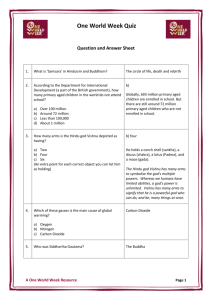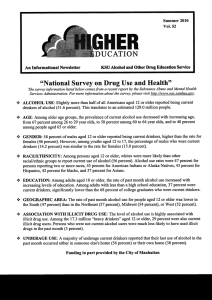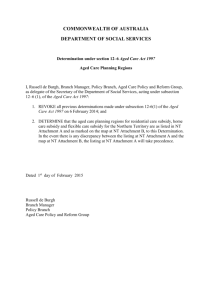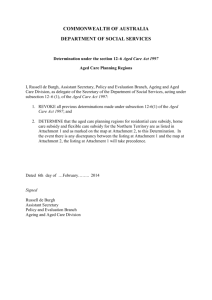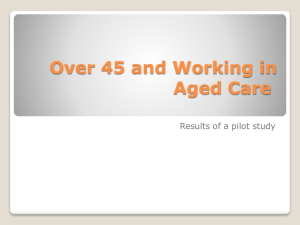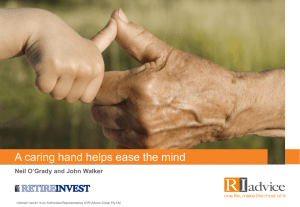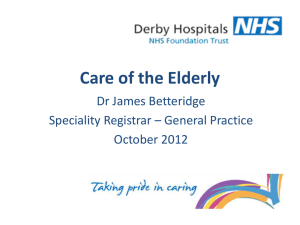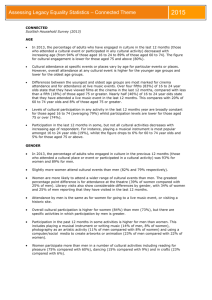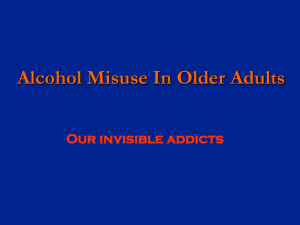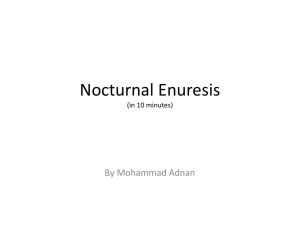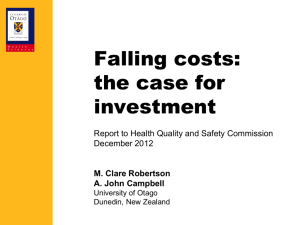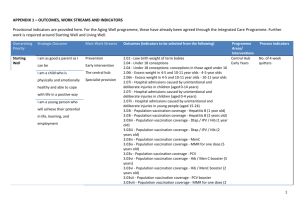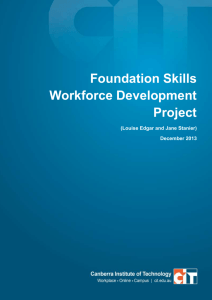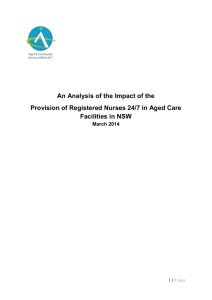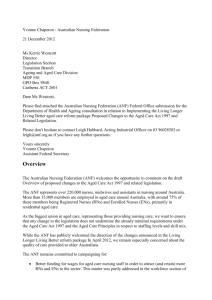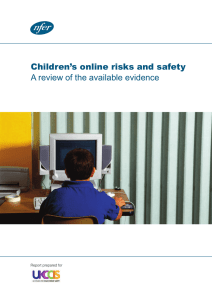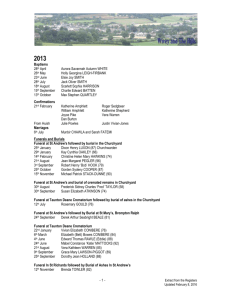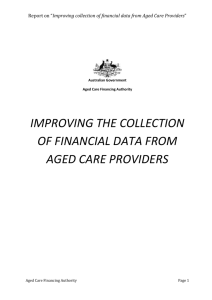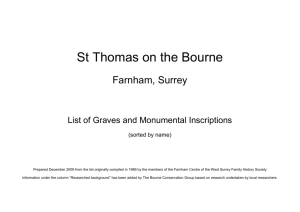Young Australians and Alcohol (Word 68 KB)
advertisement
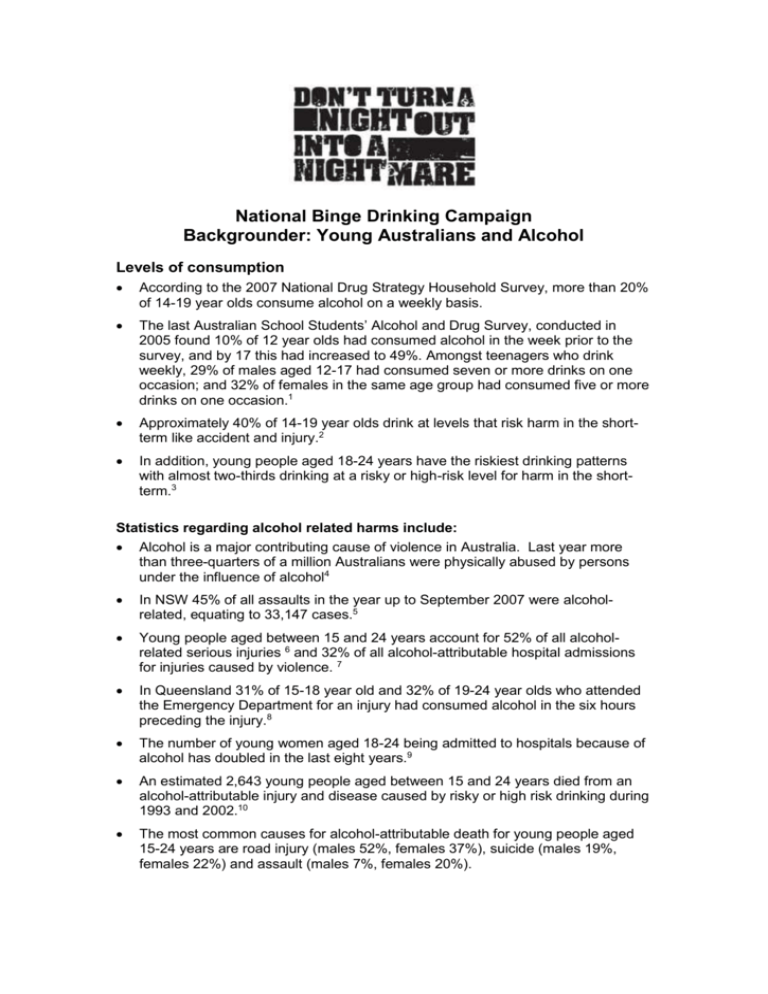
National Binge Drinking Campaign Backgrounder: Young Australians and Alcohol Levels of consumption According to the 2007 National Drug Strategy Household Survey, more than 20% of 14-19 year olds consume alcohol on a weekly basis. The last Australian School Students’ Alcohol and Drug Survey, conducted in 2005 found 10% of 12 year olds had consumed alcohol in the week prior to the survey, and by 17 this had increased to 49%. Amongst teenagers who drink weekly, 29% of males aged 12-17 had consumed seven or more drinks on one occasion; and 32% of females in the same age group had consumed five or more drinks on one occasion.1 Approximately 40% of 14-19 year olds drink at levels that risk harm in the shortterm like accident and injury.2 In addition, young people aged 18-24 years have the riskiest drinking patterns with almost two-thirds drinking at a risky or high-risk level for harm in the shortterm.3 Statistics regarding alcohol related harms include: Alcohol is a major contributing cause of violence in Australia. Last year more than three-quarters of a million Australians were physically abused by persons under the influence of alcohol4 In NSW 45% of all assaults in the year up to September 2007 were alcoholrelated, equating to 33,147 cases.5 Young people aged between 15 and 24 years account for 52% of all alcoholrelated serious injuries 6 and 32% of all alcohol-attributable hospital admissions for injuries caused by violence. 7 In Queensland 31% of 15-18 year old and 32% of 19-24 year olds who attended the Emergency Department for an injury had consumed alcohol in the six hours preceding the injury.8 The number of young women aged 18-24 being admitted to hospitals because of alcohol has doubled in the last eight years.9 An estimated 2,643 young people aged between 15 and 24 years died from an alcohol-attributable injury and disease caused by risky or high risk drinking during 1993 and 2002.10 The most common causes for alcohol-attributable death for young people aged 15-24 years are road injury (males 52%, females 37%), suicide (males 19%, females 22%) and assault (males 7%, females 20%). For people aged 18 years and under: The risks of accidents, injuries, violence and self-harm are high among drinkers aged under18 years (Chikritzhs et al 2003; Stephens 2006; Miller et al 2007). Risk-taking behaviour (Miller et al 2007), unsafe sex choices (Coleman & Cater 2005), sexual coercion (Abbey et al 2003a; Davis et al 2006) and alcohol overdose (Cheng et al 2006) increase when adolescents drink alcohol. Initiation of alcohol use at a young age may increase the likelihood of negative physical and mental health conditions, social problems and alcohol dependence (Hemmingsson & Lundberg 2001; Hingson et al 2003; Guilamo-Ramos et al 2004; Toumbourou et al 2004; Wells et al 2004; Jefferis et al 2005). Regular drinking in adolescence is an important risk factor for the development of dependent and risky patterns of use in young adulthood (Bonomo et al 2001; Australian Institute of Family Studies 2004; Wells et al 2004; Hingson et al 2003; Hingson et al 2006; Toumbourou et al 2004; Warner et al 2007; Pitkanen et al 2005). Childhood and adolescence are critical times for brain development and the brain is more sensitive to alcohol-induced damage during these times, while being less sensitive to cues that moderate alcohol intake (Kelly & Witkiewicz 2003; Brown & Tapert 2004; White & Schwartzwelder 2004; De Bellis et al 2005;). Self-reported harm scores show that drinkers under the age of 15 years are much more likely than older drinkers to experience risky or antisocial behaviour connected with their drinking, with the rates also somewhat elevated among drinkers aged 15−17 years. 1 2 The 2005 Australian Secondary Students’ Alcohol and Drug Survey. AIHW - 2007 National Drug Strategy Household Survey. Ibid. 4 AIHW. 2007. Op. cit. 5 Goh, D. and Moffat, S. (2008). New South Wales Recorded Crime Statistics 2007. NSW Bureau of Crime Statistics and Research. Attorney General’s Department, Sydney. 6 Chikritzhs, T., et.al. 2000. Op.cit. 7 Matthews, S., et.al. 2002. Op.cit. 8 Roche, A.M., Watt K., McClure R., Purdie, D.M., Green, D. (2001). Injury and alcohol: A hospital emergency department study. Drug and Alcohol Review, 20 157-168. 9 Australia New Zealand Journal of Public Health. 10 Chikritzhs, T., et.al 2004. Op.cit. 3
